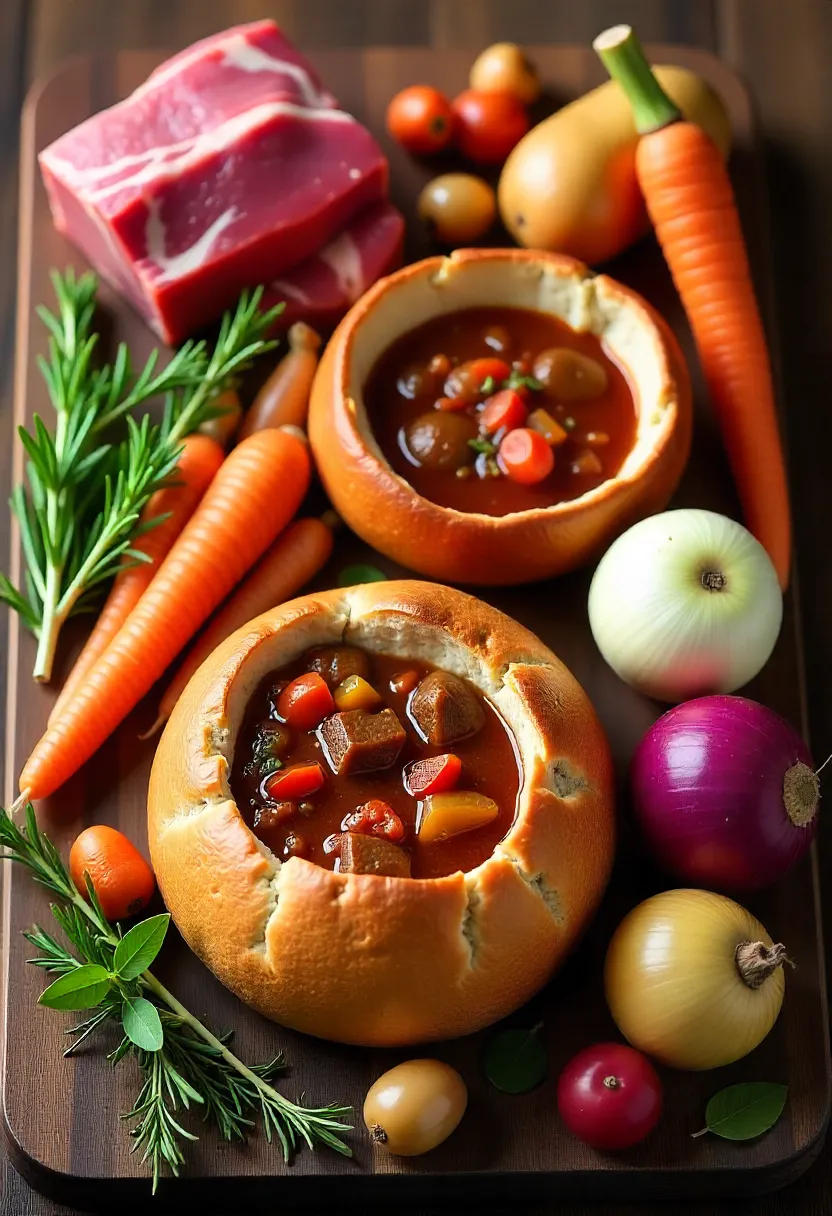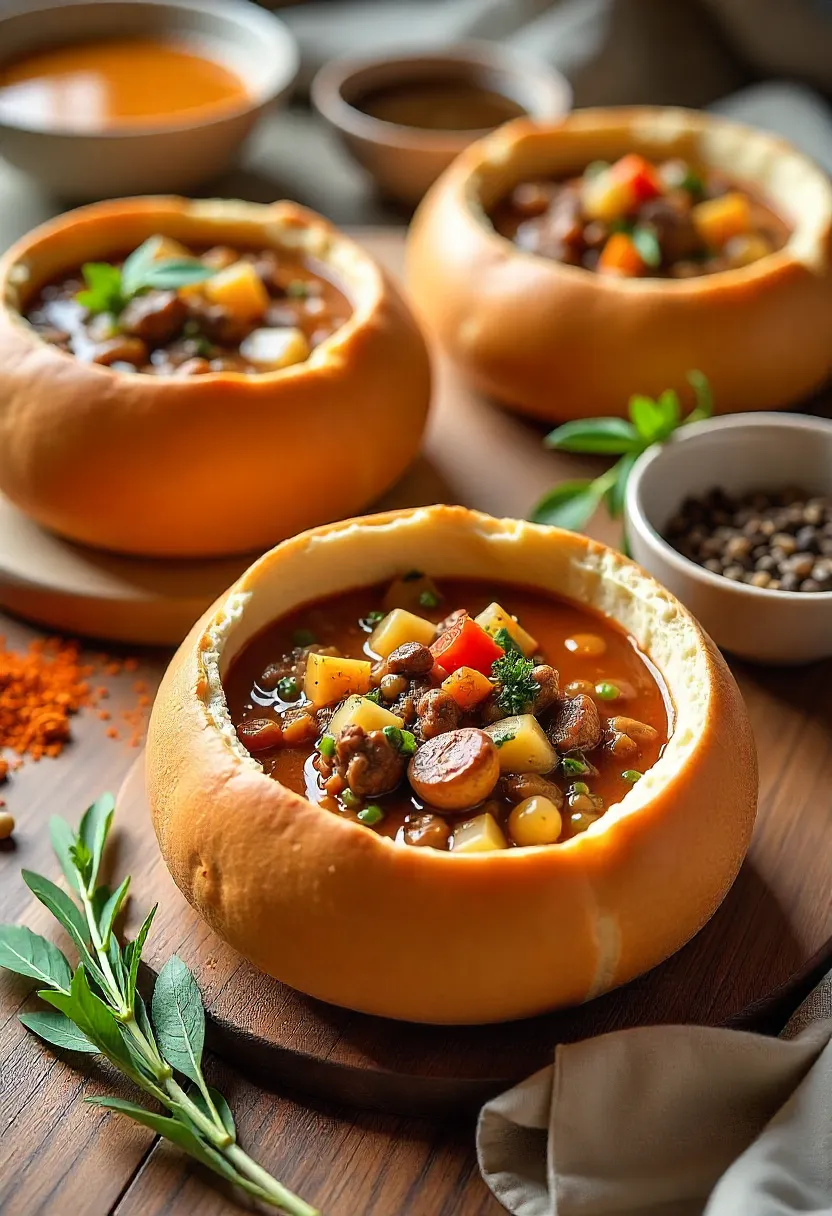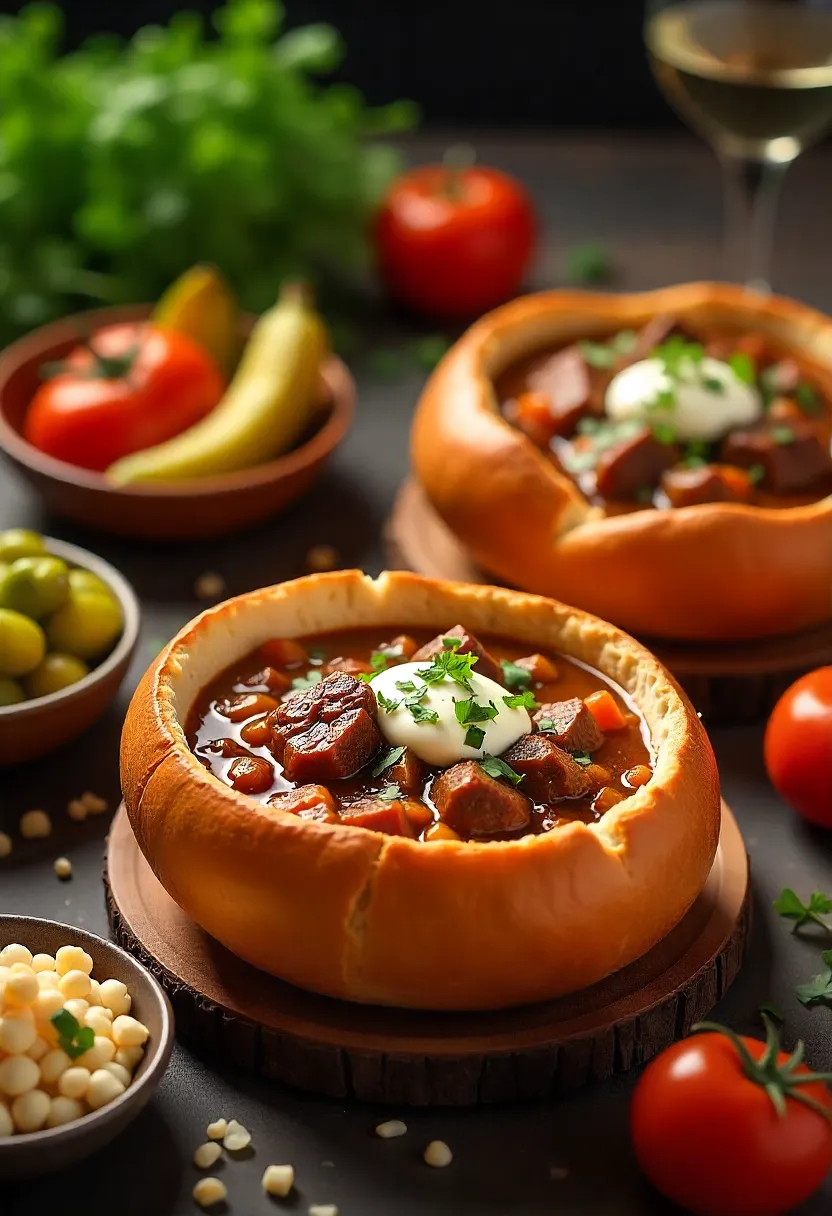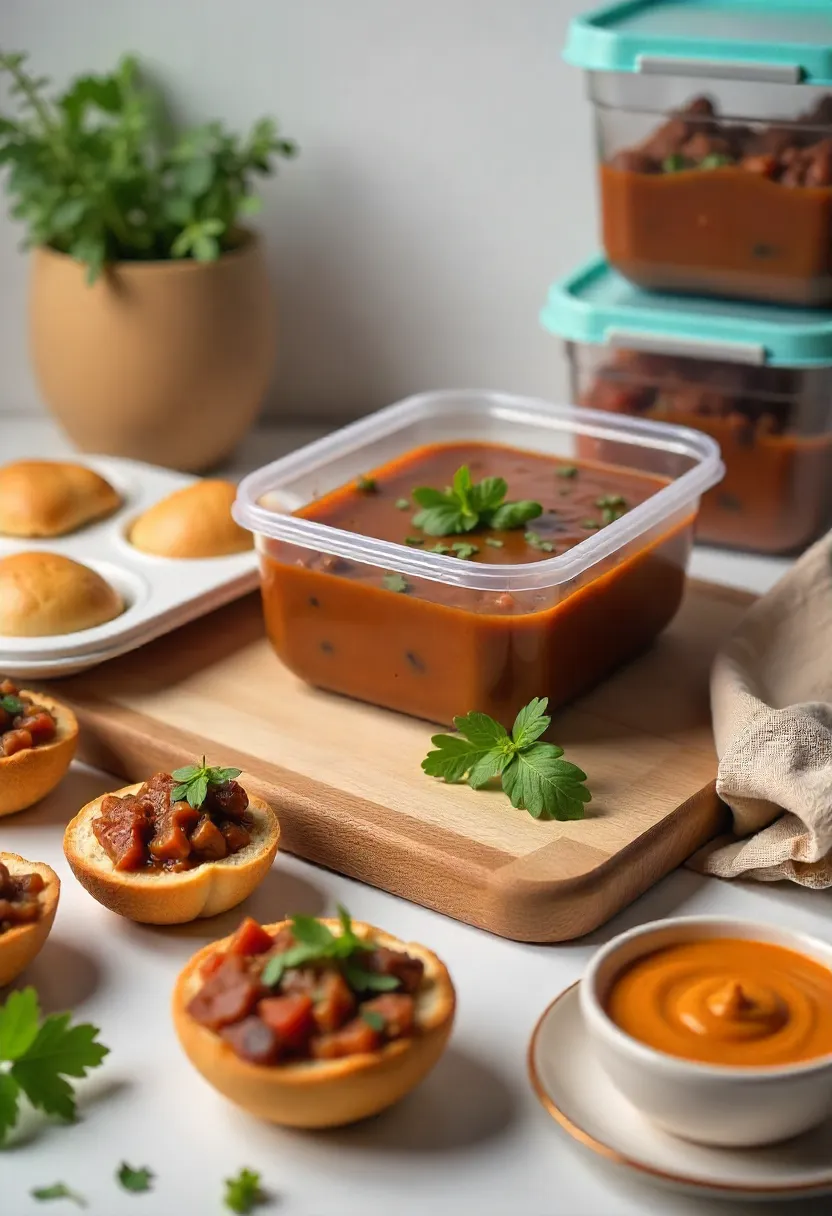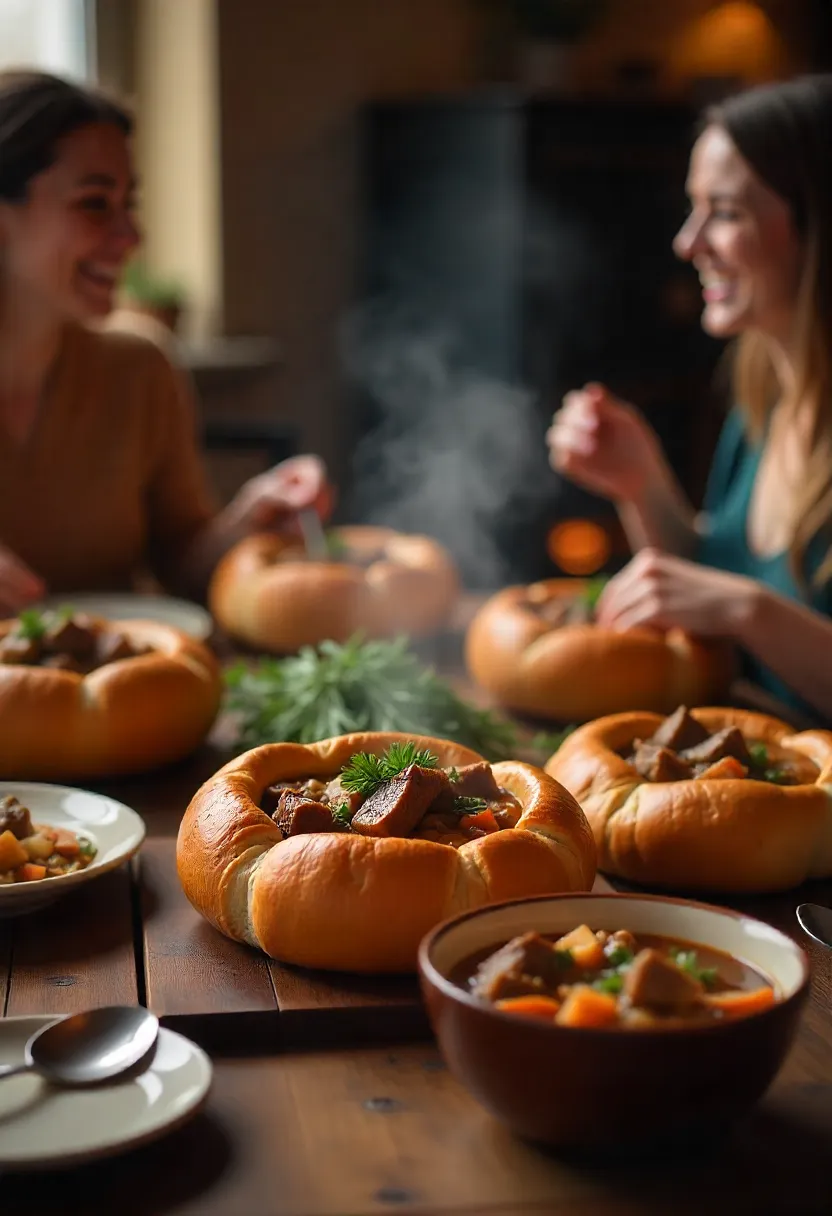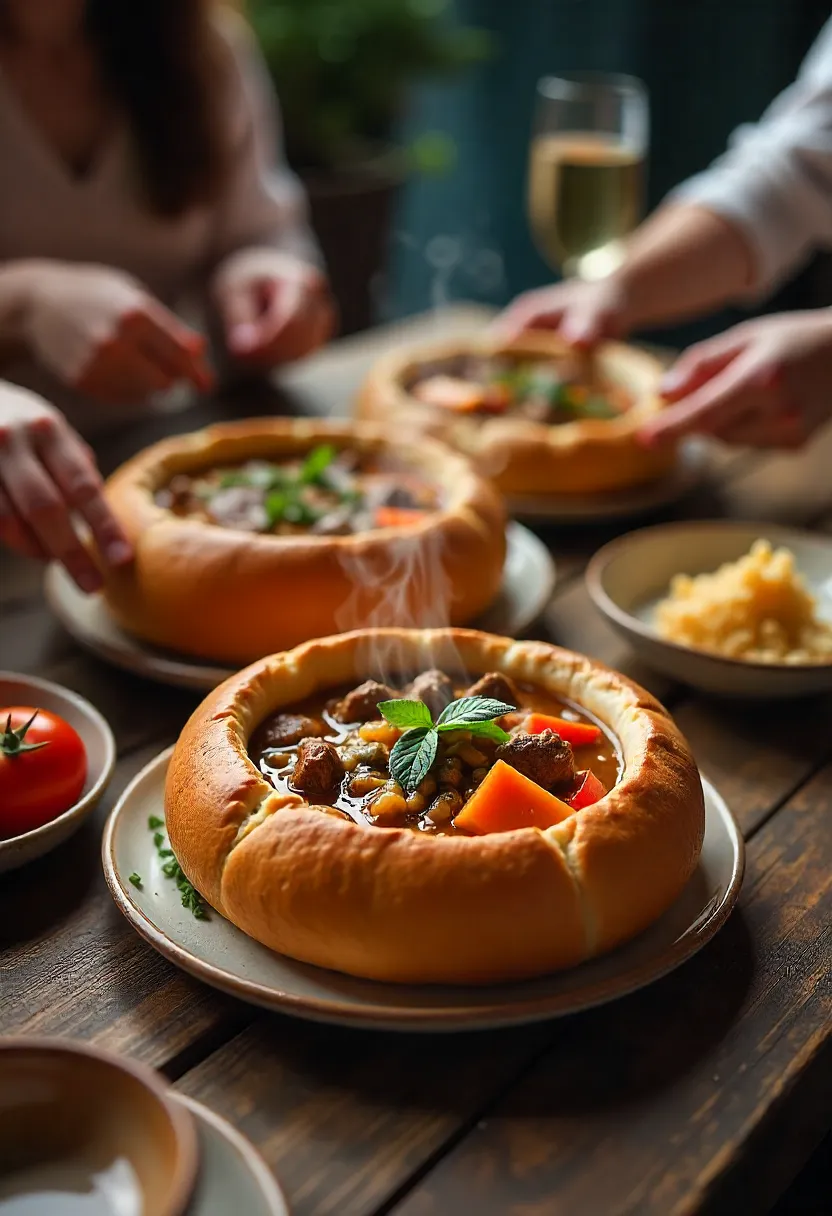Contents
- A Tale of Comfort: Why Beef Stew in Bread Bowls? 🏡💛
- Choosing the Right Ingredients: The Foundation of Flavor 🍖🥕🥔
- Cooking the Stew: Step by Step 🍲🔥
- Creative Variations and Adaptations 🌈
- Serving Suggestions & Presentation 🎉
- Storing and Reheating 🥡
- Why This Dish Feels Like Home 🏡💖
- Conclusion: Bring Joy to Your Table 🎊
There’s something magical about a dish that warms not only your stomach but also your heart. Enter the hearty beef stew in bread bowls—the ultimate comfort food that combines rich, slow-cooked beef, tender vegetables, aromatic herbs, and a crusty loaf that doubles as your edible plate. Imagine a chilly evening, the aroma of simmering meat filling your kitchen, and the anticipation of digging into a warm, crusty bread bowl brimming with savory stew. Doesn’t that make you smile already? 😋
This recipe is more than just dinner; it’s an experience. From selecting the right cut of meat to hollowing out the perfect bread bowl, every step invites creativity, care, and a little joy. Let’s dive into the full journey of creating this comforting masterpiece.🥖🥩🍲
A Tale of Comfort: Why Beef Stew in Bread Bowls? 🏡💛
Beef stew itself is timeless—a dish that has traversed centuries and continents. Originally a humble peasant meal, it became a symbol of warmth and abundance in many cultures. The idea of serving it in a bread bowl likely came from European traditions, where thick, crusty bread often doubled as a bowl to hold soups and stews. Not only does this reduce the need for extra dishes (win-win!), but it also soaks up every drop of savory goodness.
Fun story: In the 19th century, bakers in Paris would hollow out large loaves of bread and serve soups to workers on the go. Some say it was a convenient, portable way to have a hot meal during long market days. So, in a way, every time you make a beef stew in a bread bowl, you’re participating in a centuries-old tradition! 🥖✨
Choosing the Right Ingredients: The Foundation of Flavor 🍖🥕🥔
Beef: The Star of the Show
The most important component is, of course, the beef. Chuck roast is ideal because it has a perfect balance of meat, fat, and connective tissue. When slow-cooked, it becomes incredibly tender and releases gelatin that thickens the stew naturally.
Tip: Cut the beef into uniform pieces—around 2–3 cm cubes. This ensures even cooking and helps every bite be tender and juicy.
Vegetables: The Flavor Architects
Onions, garlic, carrots, celery, and potatoes form the classic medley. But feel free to experiment! Parsnips, turnips, or even sweet potatoes can add interesting twists. Each vegetable not only contributes to taste but also provides texture that balances the softness of the beef. 🥕
Fun hack: Roast your carrots and potatoes before adding them to the stew. This deepens their flavor and adds a subtle caramelized sweetness.
Herbs and Seasonings: The Silent Heroes 🌿
Fresh thyme, rosemary, bay leaves, and a dash of Worcestershire sauce transform a basic stew into a culinary masterpiece. Don’t be afraid to adjust herbs according to your taste or add a splash of red wine or beer for an even richer flavor.
Pro tip: Tie herbs in a small cheesecloth or herb sachet. This way, you can easily remove them at the end without losing the essence of their aroma.
Bread Bowls: The Edible Vessel 🥖
The bread bowl is both practical and charming. Choose a loaf with a firm crust and soft interior—sourdough or rustic country bread works beautifully. The key is leaving a sturdy wall inside so it holds the stew without collapsing.
Quick trick: Brush the interior of the hollowed-out bread with a bit of melted butter and bake for 5–7 minutes. This adds a crispy edge that prevents sogginess.
Cooking the Stew: Step by Step 🍲🔥
- Browning the Beef
Season the beef generously with salt and pepper, then lightly coat with flour. Heat oil in a large pot or Dutch oven and brown the meat in batches. This step develops the deep, rich flavor that forms the base of your stew. - Chef’s anecdote: Always brown in batches—crowding the pot steams the meat instead of browning it. Patience here makes all the difference!
- Sautéing Aromatics
In the same pot, sauté onions until translucent, then garlic until fragrant. The browned bits left from the beef are gold—scrape them up with your wooden spoon to release even more flavor.
- Building the Stew
Return the beef to the pot, add vegetables, herbs, and your choice of broth. A splash of wine or dark beer can elevate the dish to restaurant-quality richness. Bring it to a gentle boil, then reduce heat and let it simmer. - Life hack: Skim off any foam or impurities during the first 15 minutes of simmering. This results in a clearer, more refined broth.
- Slow Simmering
Cover and let the stew simmer for 1.5–2 hours. This slow cooking allows flavors to meld and the beef to become fork-tender. Stir occasionally and adjust seasoning near the end. - Final Touches
Add peas or green beans in the last 10 minutes for freshness. Remove the herb sachet and taste for seasoning. Finish with a sprinkle of fresh parsley or chives. 🌿 - Preparing the Bread Bowls
While the stew simmers, hollow out the bread loaves and bake lightly as mentioned. Just before serving, spoon the hot stew into the bowls, ensuring each one is generously filled.
Fun tip: Offer small plates on the side. Guests can tear off pieces of the bowl to scoop the stew or eat separately—it’s fun and interactive!
Creative Variations and Adaptations 🌈
- Bread options: Try rye, ciabatta, or whole grain for different textures and flavors.
- Vegetable swaps: Add mushrooms for umami depth, or roasted red peppers for sweetness.
- Flavor boosters: Smoked paprika, a dash of cayenne, or a few cloves of roasted garlic can take your stew to another level.
- Vegetarian/vegan twist: Replace beef with lentils, beans, or hearty mushrooms. Use vegetable broth and add plant-based protein for a satisfying alternative.
Story: I once made a mushroom stew in a bread bowl for a vegan friend. She declared it “better than the real thing,” and I had to admit, the depth of flavor was incredible. 🍄
Serving Suggestions & Presentation 🎉
Presentation is more than just aesthetics—it’s part of the experience! When serving your beef stew in bread bowls, consider these tips for maximum enjoyment:
- Use wide, sturdy plates: Catch drips and make the dish feel like a little masterpiece on the table.
- Add garnishes: Fresh herbs like parsley, chives, or thyme bring color and a bright aroma. A dollop of sour cream, a drizzle of melted cheese, or even a sprinkle of crispy fried onions adds richness and texture.
- Pair with sides: Complement your stew with simple, flavorful accompaniments:
- Crisp green salad with light vinaigrette 🥗
- Roasted vegetables brushed with olive oil and sea salt 🥕
- Pickled vegetables for a tangy contrast 🥒
Choose the right beverage: Balance the richness with a chilled white wine, pale ale, or sparkling water with a slice of lemon 🍷
Fun and interactive serving idea: Create a “build-your-own” bread bowl bar. Provide an array of toppings so everyone can customize their bowls:
- Grated cheeses 🧀
- Fresh herbs 🌿
- Croutons 🥖
- Sautéed mushrooms 🍄
- Chili flakes 🌶️
Kids (and adults!) will love experimenting with flavors, turning dinner into a fun, interactive event.
Storing and Reheating 🥡
Leftovers are a gift when you know how to handle them properly. Here’s how to make the most of your stew:
- Short-term storage: Keep leftover stew in airtight containers in the fridge for up to 3 days. Reheat gently on the stovetop, stirring occasionally to preserve the texture of meat and vegetables.
- Freezing: Freeze portions in airtight containers or zip-lock bags for up to 2–3 months. Thaw in the fridge overnight before reheating.
- Bread bowls: Best enjoyed fresh, but leftover shells can be:
- Toasted for croutons
- Used as mini soup cups for other meals
- Filled with dips for creative appetizers
Pro kitchen hack: Freeze stew in silicone muffin trays. Once frozen, pop the cubes into a bag for individual servings. Perfect for “instant comfort food” nights—just reheat and serve in a fresh bread bowl ⏱️.
Why This Dish Feels Like Home 🏡💖
There’s something inherently magical about digging into a hot, hearty stew served in its own bread bowl. The textures—the tender, melt-in-your-mouth beef, the soft, comforting vegetables, the thick, rich broth, and the crisp bread—create a multi-sensory experience that feeds not just the body, but the soul. It’s casual yet elegant, interactive yet hearty, and perfect for family dinners, cold winter nights, or when you need a little extra comfort.
Personal anecdote: I vividly remember a snowy evening when I invited a few friends over. The house was filled with the aroma of slow-cooked beef and herbs. Everyone laughed, talking over each other while carefully tearing pieces of their bread bowls to scoop up the stew. Dessert was forgotten that night—nobody needed it. We sat around the table, warm and full, with smiles plastered across our faces. Those are the kinds of moments that food creates: memories that linger far longer than the last bite. 🥰
Cooking this dish is not just about following a recipe—it’s about creating a space for connection, laughter, and comfort. It’s about the little joys of life: breaking bread together, sharing flavors, and savoring warmth, both in food and in friendship.
Conclusion: Bring Joy to Your Table 🎊
Hearty beef stew in bread bowls is more than a meal—it’s an experience, a tradition, and a celebration of flavor, textures, and the simple joys of life. With patience, a few thoughtful techniques, and a touch of love, you can create a dish that warms hearts as much as it fills bellies.
Take your time browning the beef, savor the scent of simmering broth, and watch as the vibrant vegetables soften to perfection. Hollow your bread bowls, carefully fill them with steaming stew, and watch as everyone at the table lights up with anticipation. This is food that doesn’t just satisfy—it delights. 🍲🥖💕
Whether it’s a cozy weeknight dinner, a special family gathering, or a snowy evening spent indoors, this dish is guaranteed to leave a lasting impression. So grab your loaf, brown that beef, stir in love and patience, and prepare for a feast that’s fun to make, comforting to eat, and unforgettable to share.



